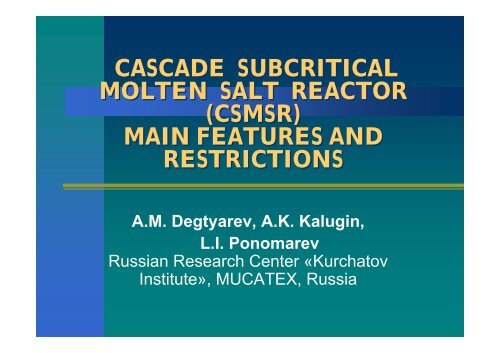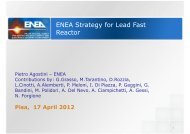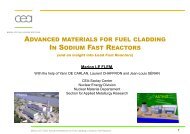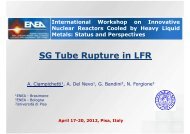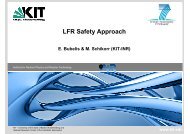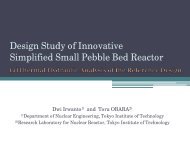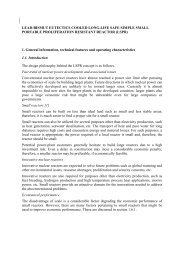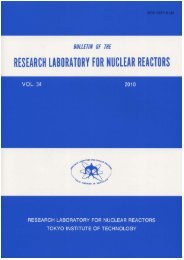CASCADE SUBCRITICAL MOLTEN SALT REACTOR (CSMSR ...
CASCADE SUBCRITICAL MOLTEN SALT REACTOR (CSMSR ...
CASCADE SUBCRITICAL MOLTEN SALT REACTOR (CSMSR ...
Create successful ePaper yourself
Turn your PDF publications into a flip-book with our unique Google optimized e-Paper software.
Ihmisen evoluutioKuva: José-manuel Benitos (http://commons.wikimedia.org/wiki/File:Human-evolution-man.png)Suvi Saarnio ja Merja Vaaramaa
TASKTHE POWER OF PROTON ACCELERATOR-DRIVER W A AND<strong>REACTOR</strong> WITH <strong>SUBCRITICAL</strong>ITY K ARE RELATED ASW A ~ 0.6K* W R i.e. W A ~30 MW at W R = 1 GWthTo reduce W A we used the cascade scheme of neutron fluxamplification wnich is based on the idea of two-cores reactor withunilateral thermal neutron flux.Our task is to investigate the possibilities ofreactor- burner based on subcritical cascadescheme
Initial assumptions and requirements• Two section cascade subcritical reactor, with zone ofcascade amplification (ZCA) and transmutation zone(TZ).• Subcriticality margin ∆Keff=0.05• 1 GeV proton accelerator driver with 10 mA current• Homogeneuos TZ with NaF-ZrF 4 molten salt
Scope of investigation• Our investigation was aimed to studyprincipal aspects concerning cascadesubcritical molten salt reactor, including:• a) proton beam conversion to neutron source;• b) main neutron-physics properties of thereactor;• c) thermo-hydraulics calculations of ZCA;d) peculiarity of the reactor safety;e) choice of molten salt; etc.• In this report we focused on neutron-physicsproblems paying less attention to other ones
Reactor composition3 main elements of the reactor-burner are proton accelerator driver,ZCA and TZ (fig.1).a) vertical section b) horizontal sectionFig. 1. <strong>CSMSR</strong> structure. 1 - reflector; 2 - TZ hull; 3 -TZ; 4 - ZCA
ZCA structureStructure of ZCA is thecritical point for efficiency ofthe whole reactor. We appliedfollowing method forelaboration of ZCA whichbased on heterogeneousscheme with fuel rods (fig. 2):71236458ZCA has a similar structureboth in radial and axialdirections.Fig. 2. ZCA structure: 1 – proton guidetube; 2 – Pu zone; 3 – Np zone; 4 – Pu fuelrods ending with Np; 5 - Pb-Bi eutectic; 6 –ZCA cladding; 7,8 – outlet and inlet tube forPb-Bi eutectic
Transmutation zone.• We taken homogeneous composition, that favors actinidesfission and allows to avoid the problems with graphite moderatorin core.• Graphite reflector minimizes the neutron losses and makessmooth power distribution.• NaF-ZrF 4 is chosen as salt composition what has preferencecompared to lithium-beryllium salt both in handling and actinidessolubility.• Zone composition forms intermediate spectrum of neutrons.When optimizing we fit configuration of TZ and salt composition, includingratio between Pu and MA components.As the result, we have obtainedTZ 230 cm height and 170 cm radius.These dimensions allow to prevent the significant ZCA interference.
Transmutation zone. Fuel (cont.)• To increase burnup of MA , we rise its fraction in thestart TZ fuel from 16% as in irradiated VVER fuel upto 25%.At the beginning of operation the salt contains3.9 mol % heavy nuclides.• For feeding composition along the operation periodwe considered :1) VVER spent fuel and2) composition with two times MA fraction increased.
Neuron-Physics CharacteristicsWe used two codes based on Monte-Carlo method:1) Russian MCU code.2) MCNP code coupled with burnup module ORIGEN. This complex wascreated within cooperation of RRC KI and FZR.The main neutrons-physics characteristics are the following:• Primary neutron source produces 19-22 fissions in core, total reactorpower is 800 MWth, with ZCA/TZ fission relation 19:81.• CAF is equal 3.• ZCA and TZ power distribution are satisfactory.• TZ reactivity effects are favourable also. Only freezing of salt haspositive reactivity effect, but even in this case the reactor is stillsubcritical with ∆Keff=0.026.• Operation time between ZCA reloading is 0.8 year with 9% fuel burnup.ZCA fuel burnup doesn’t imply a serious problem and can becompensated.
Safety issues• Being subcritical reactor with margin ∆Keff=0.05 <strong>CSMSR</strong> hassignificant advantages of critical reactors in safety issues. Butsubcritical condition entails strict undesirable limitation onreactor power level. So, taking into account <strong>CSMSR</strong> reactivityproperties we would suppose reasonable choice ∆Keff inquestion. For decreasing this margin it is necessary to correctnuclear data for MA.• Subcritical condition, using proton accelerator for power driveand stability of power distribution in <strong>CSMSR</strong> allow to eliminateCPS, including moving absorber rods.• As a reactor with one-way bond between two zones, <strong>CSMSR</strong>requires specific organization of reactivity control. At themoment we are elaborating reactivity control system for ourproduction reactors, and we are going to use our experience for<strong>CSMSR</strong>.
Efficiency of MA incinerationEfficiency calculations were carried out on the basisof the neutronics calculation results (table 1).Table 1. Initial data for calculationParameterValueCore volume 17.88 m 3Primary circuit volume 21.83 m 3TZ power645.6 MWthAverage overall circuit power 29.6 Wth/cm 3densityNeutron flux 5·10 14 n/(cm 2 s)Actinide losses during0.1%reprocessingCore reprocessing period1200 daysAnnual load300 daysPower density and neutron flux are rather far from desirable values.
Efficiency of MA incineration (cont.)We calculated incineration capacity averaged along 50 years operation period for 2 options of feedcomposition. The table 2 presents our results in comparison with incineration characteristics of homogenouscritical burner SPHINX in equilibrium.Table 2. Incineration characteristics <strong>CSMSR</strong> compared to SPHINX.Parameter<strong>CSMSR</strong>SPHINXVVER spend fuel VVER spend fuel withincreased MA fractionMolar concentration of actinides in salt*, % 6 7 0.75Mass of actinides in primary circuit*, kg 9851 11868 3600Specific mass of actinides in primary 12.3 14.8 3.0circuit*, kg/MWthActinides composition U/Np/Pu/Am/Cu*, 1.7/2.1/83.3/9.5/3.4 2.1/2.1/79.6/13.0/3.3 0.4/1.5/72.5/7.5/18%Incineration capacity HM/MA/Np**, 193.7/26/20 193.7/51/19.3 ~365/25.7/16kg/yearSpecific incineration capacity HM/MA/Np**, kg/TWhth33.6/4.5/3.5 33.6/8.9/3.4 ~42/2.9/1.8Comment: * - end of <strong>CSMSR</strong> operation, ** - evaluations for SPHINX under the data presented in MOST report<strong>CSMSR</strong> requires a large specific fuel loading. Concerning incineration characteristics <strong>CSMSR</strong>compared with SPHINX (thermal power is 1215MW) has advantages for MA incineration. With 30years cooling period VVER annually produces 32.4 kg MA and 15.2 kg Np. Thus, concerning MAincineration <strong>CSMSR</strong> can support up to 1.6 VVER.
Conclusions• Cascade scheme can reduce ~3 times the power ofaccelerator-driver at fixed blanket power.• <strong>CSMSR</strong>-burner with W A =10 MW, W R =800 MWth andsubcriticality ∆Keff=0.05 can incinerate ~50 kg of MAper year, i.e. MA produced by 5 thermal reactor of thesame power.• Restriction ∆Keff=0.05 should be analyzed morecarefully using the new MA nuclear data.• Disadvantage of <strong>CSMSR</strong> is the intermediate neutronspectrum in TZ and as consequence the high ratioPu/MA ~ 4/1.• To enchance the efficiency of ADS-burner it isnecessary to enlarge the cascade amplification factorand to reduce Pu/MA ratio.


